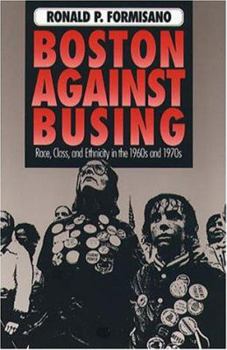Boston Against Busing: Race, Class, and Ethnicity in the 1960s and 1970s
Select Format
Select Condition 
Book Overview
In the 1970s the flashpoint of race relations for many white Americans was court-ordered busing to achieve school desegregation. Busing sparked protests in almost every city in which it was implemented, but perhaps the most volatile reaction occured in Boston, a city known for its high culture, superior education, and liberal populace. In no other city, north or south, did school desegregation prompt such intense and protracted protest.
In...
Format:Paperback
Language:English
ISBN:0807842923
ISBN13:9780807842928
Release Date:March 1991
Publisher:University of North Carolina Press
Length:368 Pages
Weight:0.10 lbs.
Dimensions:1.0" x 6.1" x 9.3"
Related Subjects
20th Century Civil Rights Civil Rights & Liberties Education Education & Reference Education Theory Gay & Lesbian History Political Science Politics & Government Politics & Social Sciences Reform & Policy Schools & Teaching Social Science Social Sciences Sociology Specific Topics State & Local TextbooksCustomer Reviews
3 ratings
Excellen look at the ills of busing
Published by Thriftbooks.com User , 17 years ago
Read this for graduate American history course. Ronald P. Fonnisano's book , Boston Against Busing: Race, Class, and Ethnicity in the 1960s and 1970s, is an excellent insight into busing struggles in Boston. Boston Public Schools is the oldest public school system in the United States. Boston Latin (1635) was the first public high school and The Mather School (l939) is the oldest free public school. Before 1974, Boston was known as the home of abolitionists and reformers. It had the reputation of being the most educated city with the oldest university and the most college students per square mile. It was called 'The Athens of America." This nickname evoked enlightened thinking. However, that was the last adjective that television viewers would use to describe the violent mobs that attacked school buses in South Boston on the fall of 1974. The events on September of 1974 marked the beginning of the most violent period in the city of Boston since the Revolutionary War. Under pressure from African American parents and the National Association for the Advancement of Colored People, Judge W. Arthur Ganity issued the order to desegregate the Boston public schools. Legally the schools had been desegregated in 1855 but in practice they were not. On the first day of school most students boycotted classes and protesters mobbed the school busses and entrances. Protests continued non stop for years. Historian Ronald P. Formisano was living in Cambridge, Massachusetts at the time and he was teaching a college class on the desegregation of the Boston schools. His book, Boston Against Busing, focuses on the actions and motives of the white anti-busing protesters. Formisano writes that even though all schools in Boston were deteriorating physically and instruction wise and Boston students were scoring low on national standardized tests, ghetto schools were worse than white neighborhood schools. I Less money was spent on African American pupils than on white students. Formisano points out that the schools were subject to the political whims of school committee politics. African American protests went unheard because they were the minority and politicians only cared about the votes of the white majority. Following years of waiting to be heard, African American parents accused the Boston School Committee of intentionally keeping schools segregated in violation of the 14th Amendment. The class action suit trial began in 1970 and judge Ganity made his decision in favor of the plaintiffs on June of 1974. He presided over the desegregation of the Boston schools and began in pmt with busing students from Roxbury, the poorest African American neighborhood in Boston to South Boston, the poorest white neighborhood in Boston. Geographically this made some sense since these are bordering areas of Boston. The people in both neighborhoods were of different races and ethnicities yet they had very similar problems. Formisano explains that businesses always set up shop in
No difference between Boston & Birmingham
Published by Thriftbooks.com User , 21 years ago
Funny how busing caused such a flap in Boston and no southerners hopped on buses to go demonstrate in the streets of Boston.
excellent reassessment of a controversial subject
Published by Thriftbooks.com User , 23 years ago
Ronald Formisano's "Boston Against Busing" is the single most valuable -- though not the most significant -- book about the school integration crisis in Boston in the mid-1970s. Contrary to the prevailing thought on the Boston busing imbroglio, Formisano argues that the crisis was not only a manifestation of rage and racism, but was also the natural reaction of working-class and ethnic Bostonians to a decade's worth of promises from public officials that busing would never come to Boston. Indeed, a number of public officials in Boston, such as School Committee Chairwoman/Mayoral Candidate Louise Day Hicks and School Committee member Jim Kerrigan, built their careers on such promises, which primarily served to do nothing more than enflame the passions of citizens. Another thorny aspect of the crisis that Formisano handily details is the perceptive anger and resentment of working class and white ethnic Bostonians that their neighborhoods were hijacked for social experimentation by so-called "limousine liberals" from the suburbs. This anger, which welled up in South Boston, Charlestown and other sections of the city, arose from the fact that schools like South Boston High School and Charlestown High School were no more white and non-integrated than the suburban school systems in which the judges and politicians who ordered busing lived - yet it was the city schools that faced federal orders to integrate. Formisano has written an incisive book that moves forward our knowledge of the Boston busing crisis. The book cuts more directly to the heart of the situation than J. Anthony Lukas' "Common Ground," which is a far more celebrated work. Formisano's book is more scholarly and research-driven and less anecdotal and windy than Lukas' book. Overall, "Boston Against Busing" is highly recommended.





